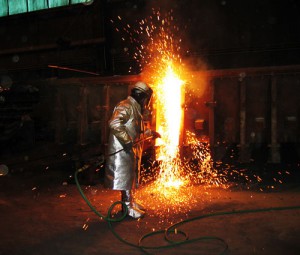Since Mesothelioma Uncertain to Occur from Asbestos Exposure, Washington Court of Appeals Affirms Summary Judgment for Plaintiff’s Former Employer
September 4, 2015
News and Views on Environmental & Toxic Tort Federal and State Legal Issues and Developments
September 4, 2015
Last year’s decision of the Washington Supreme Court in Walston v. Boeing, 181 Wn.2d 391, 334 P.3d 519 (2014 ), affirmed the narrow scope of the state’s statutory exception from worker’s compensation pre-emption – a plaintiff must prove an employer’s deliberate intention to cause his injury to avoid pre-emption and file a civil lawsuit for tort damages in excess of worker’s compensation benefits. In Kalahar v. Alcoa, Appeal No. 72635-8-1 (August 24, 2015) (unpublished), the plaintiff tried an end-run around Walston which, if adopted, would have rendered pre-emption illusory and opened employers up to civil liability in myriad circumstances. Instead, the Court of Appeals saw through the attempt to circumvent Walston and reaffirmed that the deliberate injury exception to workers compensation immunity did not apply as a matter of law because – citing the plaintiff’s own medical experts – there was no evidence that the employer knew asbestos exposure was certain to cause compensable injury to the plaintiff.
), affirmed the narrow scope of the state’s statutory exception from worker’s compensation pre-emption – a plaintiff must prove an employer’s deliberate intention to cause his injury to avoid pre-emption and file a civil lawsuit for tort damages in excess of worker’s compensation benefits. In Kalahar v. Alcoa, Appeal No. 72635-8-1 (August 24, 2015) (unpublished), the plaintiff tried an end-run around Walston which, if adopted, would have rendered pre-emption illusory and opened employers up to civil liability in myriad circumstances. Instead, the Court of Appeals saw through the attempt to circumvent Walston and reaffirmed that the deliberate injury exception to workers compensation immunity did not apply as a matter of law because – citing the plaintiff’s own medical experts – there was no evidence that the employer knew asbestos exposure was certain to cause compensable injury to the plaintiff.
Plaintiff John Kalahar worked at the defendant’s aluminum smelter plant in Wenatchee, Washington in the 1960s and early 1970s. Mr. Kalahar and his wife sued his former employer in 2014 after he was diagnosed with mesothelioma, a form of lung cancer generally associated with asbestos exposure. Under the Washington Industrial Insurance Act, employees injured in the course and scope of their employment are generally limited to the recovery of workers compensation benefits without proof of fault, while employers receive immunity from civil suits by workers. However, plaintiffs argued here for application of the statute’s narrow exception allowing an employee to sue an employer in tort for a work-related injury which results “from the deliberate intention of his or her employer to produce such injury.” RCW 51.24.020. The trial court granted the defendant employer’s motion for summary judgment based on its lack of actual knowledge that (1) the plaintiff was certain to develop mesothelioma and (2) the company willfully disregarded such knowledge.
Applying the Washington Supreme Court’s recent decision in Walston, the Court of Appeals upheld summary judgment for the former employer. In Walston, the Supreme Court held an employer’s knowledge that asbestos exposure to its employees may cause an asbestos-related disease does not establish a “deliberate” injury because asbestos exposure is not certain to cause mesothelioma and thus the employer cannot have actual knowledge that compensable injury was certain to occur. Walston rejected as insufficient the testimony offered by plaintiff’s expert Dr. Arnold Brody that asbestos exposure would cause changes at the cellular level, because the claimed compensable injury was mesothelioma, not cellular changes. The Supreme Court also relied on testimony by plaintiff’s expert Dr. Andrew Churg admitting that asbestos exposure is not certain to cause mesothelioma or any other disease. The Kalahars used the same experts (Dr. Brody and Dr. Churg) as the plaintiffs had in Walston and could not demonstrate the certainty that Mr. Kalahar would actually develop mesothelioma more than forty years after he left the defendant’s employment.
The Court of Appeals in Kalahar rejected the plaintiffs’ attempt to distinguish Walston. The Kalahars attempted to argue that – unlike in the Walston case – Mr. Kalahar had shown immediate symptoms from asbestos exposure demonstrated by coughing, sneezing, and skin irritation. But the Court of Appeals held that Walston reached its holding because asbestos exposure is not certain to cause disease regardless of whether contemporaneous physical symptoms existed:
The Kalahars attempt to distinguish Walston based on their evidence of Kalahar’s contemporaneous physical symptoms claiming that none existed in Walston. But, the Walston court ultimately reached its conclusion by reasoning that asbestos exposure is not certain to cause mesothelioma or any other disease – not because Walston failed to provide evidence of physical injury – contemporaneous or delayed. 181 Wn.2d at 397. (“[Asbestos exposure] does cause a risk of disease, but as we have previously held, that is insufficient to meet the [applicable] standard.”). Like the expert in Walston, the Kalahars’ expert admitted that asbestos exposure, at any level, is never certain to cause mesothelioma or any other disease. We are bound by the Supreme Court’s decision in Walston. Therefore, we conclude that the Kalahars have not raised a genuine issue of material fact as to whether Alcoa had actual knowledge that the injury—mesothelioma – was certain to occur.
The Court of Appeals further rejected the plaintiff’s argument that Walston effectively “removes occupational diseases from the intentional injury exception” by noting that prior Supreme Court precedent have required that an employer knew with certainty that the injury would occur and that “the legislature has not taken issue” with those cases.
Seattle Partners Mark Tuvim and Kevin Craig handled the appeal, with Tuvim arguing the case before the Court of Appeals. The Kalahars have thirty days to file an expected petition for review to the Washington Supreme Court.